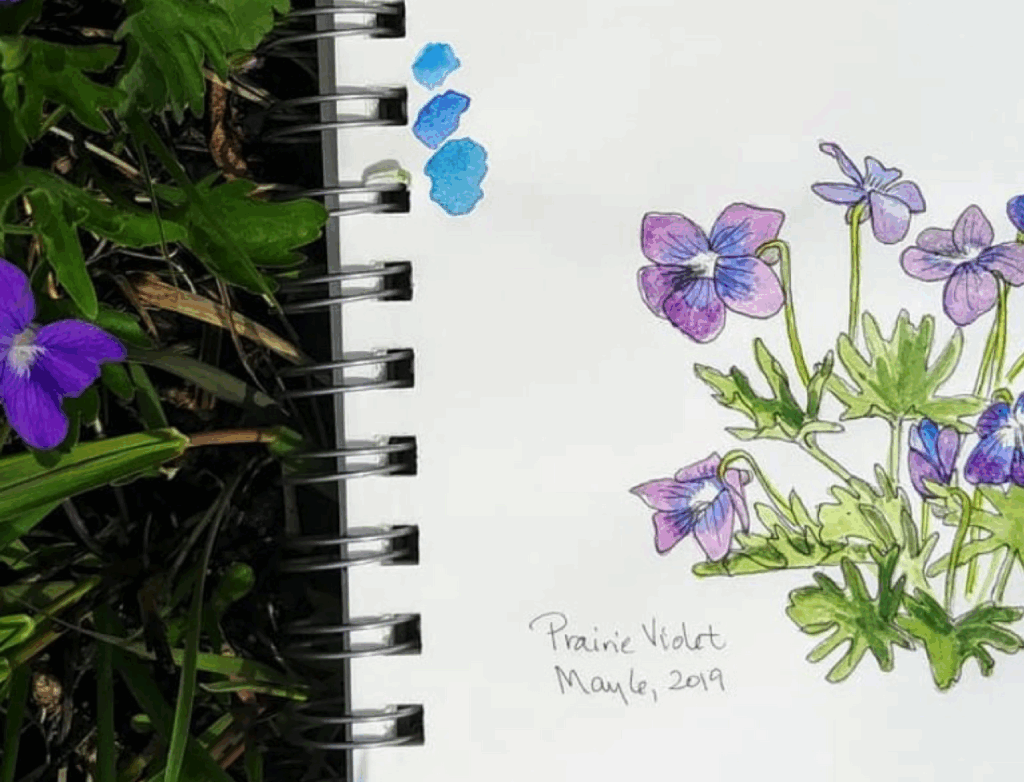Karen Johnson Celebrates Life’s Diversity in her Art

The curled up fingers of a dried compass plant leaf, moody blue-gray clouds hanging low over yellowed grasses, a formation of sandhill cranes migrating across a partly cloudy sky. These are some of the observations made in natural science illustrator Karen Johnson’s sketchbook, and which she shares on her Instagram (@karensnatureart) and at karensnatureart.com.
Living in Naperville, with degrees in both entomology and biological illustration, Karen’s art practice is grounded in her strong science background. “I’ve loved art ever since I was little and I’ve also loved insects ever since I was little,” she told the Nodding Onion. “I was in the middle of my entomology degree when I discovered that Iowa State had a biological illustration program and I was like, oh, that sounds really cool.”
“That’s the feeling that I try to bring about in my artwork, that awe that I see.”
Art has proven a way for Karen to connect other people to the beauty of the natural world that might otherwise be overlooked. “The fact that I can show what I find fascinating about insects and plants in my art is what I really enjoy doing,” Karen said. There is a reverential quality to her work that one might not necessarily find in a textbook scientific illustration. “There’s so much variety and diversity [in the world] and the more I study it, the more amazed I am,” she explained. “That’s the feeling that I try to bring about in my artwork, that awe that I see.”
Karen’s plans to observe spring emerging at the Schulenberg Prairie at the Morton Arboretum, where she teaches art classes, were disrupted by the COVID-19 pandemic.
“It’s like you’re a discoverer—even if other people have made these discoveries, you haven’t.”
With the arboretum closed, and other natural areas getting more crowded, she’s finding things to study in her yard and neighborhood. “I guess I took it for granted that I was able to go draw in these places, and I didn’t realize how much they actually affect me,” she said. “When I go out there, it clears my head, it brings me joy, it brings me peace. If I’m worried about something I can focus on something else for a while, and just be rejuvenated.”
Karen’s sketching practice, and returning to the same places throughout the year, allows her to slow down and observe more closely. “You start seeing all the connections there are and how things interrelate […] and how we as people have an effect for good or bad on a habitat.”
Though she is also a photographer, drawing in the field opens her up to experiences she wouldn’t have if she simply snapped a picture and walked away. “I’ll have birds come in and land just a few feet from me, or a hummingbird will come check me out,” she said. While drawing, she once watched a blue gentian open up as the sun came out. “I had no idea that it would open up like that because the white ones I had drawn always stayed closed. “So it’s like you’re a discoverer—even if other people have made these discoveries, you haven’t.”
The prairie has been a primary focus of Karen’s work for the past few years after she connected with Cindy Crosby, a naturalist, author, and steward of the Schulenberg Prairie, where Karen now volunteers. “I don’t think I could ever learn everything there is to learn—there are hundreds of plants and probably thousands of insects in the prairie, even in the tiny Schulenberg.”
“A nature journal is for observing and for getting down things on paper that you want to remember.”
Asked about advice for starting a nature journaling practice, Karen said: “A nature journal is for observing and for getting down things on paper that you want to remember, so it’s a memory keeper. Or if you’re a scientist, it’s where you put your observations.”
As for how and where to get started, “You can even start one in your own yard—what flowers are blooming in my yard? What insects do I see? What animals do I see? You can just scribble, you can just draw what you see.” And there is plenty to see, even in the highly urbanized Chicagoland area. “People always think, well if it’s beautiful, it has to be a mountain or an ocean,” Karen said.
“I guess I want to get across that where we live, there is beauty here. Even in the prairie, even in the middle of winter, the prairie can be beautiful. It’s a different kind of beauty and we have to open our minds and our hearts to it.”




